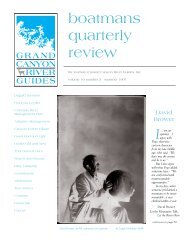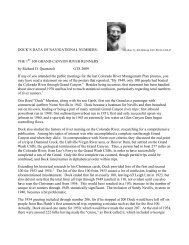summer 07 / 20:2 - Grand Canyon River Guides
summer 07 / 20:2 - Grand Canyon River Guides
summer 07 / 20:2 - Grand Canyon River Guides
You also want an ePaper? Increase the reach of your titles
YUMPU automatically turns print PDFs into web optimized ePapers that Google loves.
Your Celestial Friends<br />
As a <strong>Grand</strong> <strong>Canyon</strong> enthusiast, you are most<br />
likely a frequent admirer of the night sky.<br />
Perhaps you wish to better understand the<br />
heavens above, and the relationships different celestial<br />
bodies have to one another. We covered the basics of<br />
these “celestial mechanics” in the winter article (bqr<br />
19:4), and today we will go a step further, exploring the<br />
wonders of our solar system’s planets.<br />
The word planet is Greek for “wanderer,” and indeed<br />
these reflective bodies move about the celestial map,<br />
holding no fixed positions. But their movement is<br />
precise and predictable, and can be charted along a<br />
specific plane of (or circle<br />
around) the celestial sphere.<br />
This plane is called the ecliptic.<br />
The ecliptic can perhaps<br />
best be visualized from an<br />
“above” perspective, using the<br />
attached diagram. The planets<br />
revolve around the sun on an<br />
almost flat plane, so that, as<br />
seen from Earth in the night<br />
sky, all the planets lie within a<br />
straight line. Project this plane<br />
outward onto the celestial<br />
sphere, and it aligns with the<br />
constellations forming the band<br />
of the zodiac, (which, for<br />
purposes of clarity, are the only<br />
ones represented on this<br />
diagram.)<br />
Place yourself now on planet<br />
Earth in this diagram, and<br />
imagine yourself looking<br />
outward toward the other<br />
planets. Each of them is either<br />
blocked by the sun or falling in<br />
line with a zodiacal constellation.<br />
This is a constant of the<br />
night sky: the planets will only<br />
be seen within the constellations<br />
of the zodiac.<br />
As we revolve around the<br />
sun in a year’s time, the sun’s<br />
position also falls along the<br />
ecliptic, spending approximately<br />
one month “in” each of the<br />
zodiacal constellations. Because<br />
Earth is tilted 23 degrees to the<br />
axis of its orbit, the celestial<br />
equator is offset 23 degrees from<br />
the ecliptic. There are, then,<br />
GEMINI<br />
TAURUS<br />
CANCER<br />
North<br />
Celestial<br />
Pole<br />
ARTES<br />
celestial equator<br />
two points on the celestial sphere at which these circles<br />
converge, above which the ecliptic is in the northern<br />
celestial hemisphere, and below, the southern. (As an<br />
interesting side note to our planetary lesson, these two<br />
points of convergence are the vernal and autumnal<br />
equinoxes. Which is to say, on March 21, the sun lies<br />
directly between Earth and the point of convergence in<br />
line with the constellation Pisces, and on September 23,<br />
the same is true for the point in Virgo.) The offset of<br />
these two planes governs where the ecliptical constellations<br />
rise and set on our horizon, and the band they<br />
trace across the celestial sphere.<br />
LEO<br />
Mars<br />
Saturn<br />
23 o<br />
PISCES<br />
Earth<br />
VIRGO<br />
vertical line<br />
to the plane<br />
of the eclipse<br />
Venus<br />
Mercury<br />
AQUARIUS<br />
LIBRA<br />
celestial equator<br />
Jupiter<br />
CAPRICORN<br />
SCORPIO<br />
This drawing illustrates the relationships between the celestial equator, the ecliptic, the<br />
zodiacal constellations, the planets' orbits around the sun, and how we chart them along<br />
the larger circle—the celestial sphere. (Adapted from Rey, p.119 & p.131.)<br />
SAGITARIUS<br />
page <strong>20</strong><br />
grand canyon river guides

















